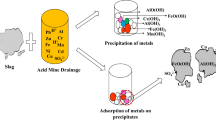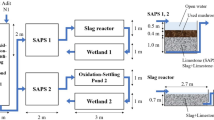Abstract
Steel slag from the Waylite steel-making plant in Bethlehem, Pennsylvania was leached with acidic mine drainage (AMD) of a known quality using an established laboratory procedure. Leaching continued for 60 cycles and leachates were collected after each cycle. Results indicated that the slag was very effective at neutralizing acidity. The AMD/slag leachates contained higher average concentrations of Ba, V, Mn, Cr, As, Ag, and Se and lower average concentrations of Sb, Fe, Zn, Be, Cd, Tl, Ni, Al, Cu, and Pb than the untreated AMD. Based on these tests, slag leach beds were constructed at the abandoned McCarty mine site in Preston County, West Virginia. The leach beds were constructed as slag check dams below limestone-lined settling basins. Acid water was captured in limestone channels and directed into basins to leach through the slag dams and discharge into a tributary of Beaver Creek. Since installation in October 2000, the system has been consistently producing net alkaline, pH 9 water. The treated water is still net alkaline and has a neutral pH after it encounters several other acidic seeps downstream.
Similar content being viewed by others
Author information
Authors and Affiliations
Rights and permissions
About this article
Cite this article
Simmons, J., Ziemkiewicz, P. & Courtney Black, D. Use of Steel Slag Leach Beds for the Treatment of Acid Mine Drainage. Mine Water and the Environment 21, 91–99 (2002). https://doi.org/10.1007/s102300200024
Published:
Issue Date:
DOI: https://doi.org/10.1007/s102300200024




